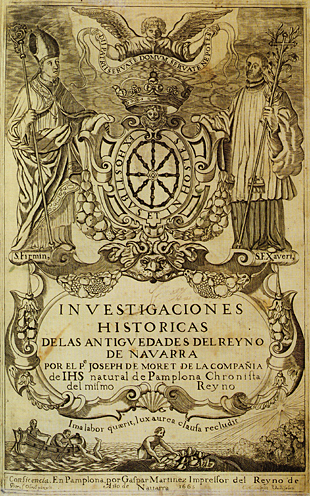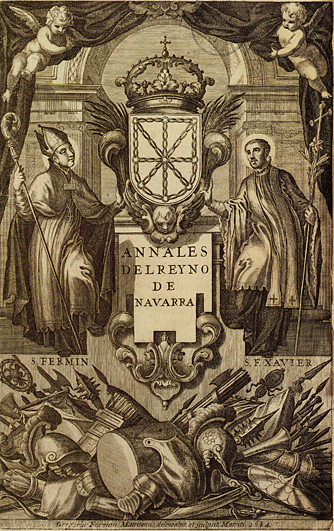The piece of the month of July 2008
SAINT FRANCISCO JAVIER AND SAINT FERMIN, IN A PAINTING IN THE PARISH CHURCH OF SAN PEDRO DE ELGORRIAGA
María Josefa Tarifa Castilla
Chair de Patrimonio y Arte Navarro
The images of Saint Francis Xavier paired with Saint Fermin were widely disseminated from the second half of the 17th century onwards, after they were declared equally principal patrons of the Kingdom of Navarre by sanction of Pope Alexander VII in April 1657. Particularly important in the dissemination of this iconography of Xavier were several engravings that appeared in some books by Father Moret, chronicler of the Kingdom and author of his famous Annals, very widespread in the 16th century, in which the figure of Saint Francis Xavier could be found. One of the images which, due to its nature as a book cover, was widely disseminated and was used as model by sculptors and painters, is the one illustrating the author's work Investigaciones históricas de las antigüedades del Reyno de Navarra, which came out in 1665, composed by the Flemish painter Pedro de Obrel and engraved by Cañizares, who opened copperplate in Valladolid. The print sample shows San Fermín and San Francisco Javier as co-patron saints of Navarre holding the arms of the Kingdom, framed in an ostentatious cartouche with pinjantes of fruit. The image of Javier with cassock, surplice and stole, cross and staff of lilies is the one that was most successfully disseminated in Navarre and throughout Spain during the Baroque period. Similarly, in the first edition of the Annals of Navarre, printed in Pamplona in 1684, another print shows both Navarrese saints in the same arrangement and iconography, in a composition with few variations, the work of Gregrorio Fosman y Medina, a Flemish engraver who died in Madrid in 1713. These illustrations of Father Moret's works have precedents in other engravings of important book covers made half a century earlier by Juan de Courbes, although naturally the place of San Fermín is occupied in this case by other Jesuit saints.

Anonymous. "San Francisco Javier and San Fermín", third quarter of the 17th century.
Parish Church of San Pedro, Elgorriaga
sample A good example of the dissemination of the covers of Father Moret's books are some canvases that copy their content and form, such as the illustration of the Navarrese co-patrons of the Investigaciones Históricas. Thus, the illustration of the Navarrese co-patrons of the Investigaciones Históricas was recreated by the painter of the present painting, with some modifications to the composition, such as the removal of the coat of arms of Navarre. The canvas, located on the side of the Epistle of the parish church of San Pedro de Elgorriaga, invoice popular and of large dimensions, was painted in the third quarter of the 17th century. The saints are depicted on either side of the painting, full-length, upright, looking at the viewer, on the left the first bishop of Pamplona, imparting the blessing and holding the crosier, and on the right the Jesuit with the cross and a staff of lilies in his left hand. The crucifix is the primary symbol of the missionary, one of the most common in all representations of Saint Francis Xavier and the protagonist of such popular scenes from his life as the crab that returned it to him after the storm. For its part, the lily is a motif that has appeared between the hands of the Navarrese saint since the earliest representations. Only later, when this symbol of purity peculiar to Saint Aloysius Gonzaga, beatified in 1605 and canonised in 1726, was considered a symbol of purity, did it disappear from the iconography of Saint Francis Xavier, although the specific fact that passed into his biographies was recorded by Father Francisco Vázquez in a letter of 1596 in which he relates a passage from the life of the saint alluding to the preservation of his virginity.

Pedro de Obrel, engraving on the cover of the Investigaciones históricas de las Antigüedades del Reyno de Navarra, by José Moret, 1665.
The richness of colour is reflected in the clothing of the saints, who are set against a neutral background and framed at the top by a red drapery. Saint Francis Xavier is depicted with a young, bearded face and symmetrical hair, wearing a black Jesuit cassock over which is a long white surplice with a round neck and wide sleeves, a liturgical ornament that adds to the figure's baroque appearance, and to which is superimposed the gold-edged stole. Saint Fermín is dressed in the episcopal vestments, chirothecae on his hands, pectoral, white alb, red stole and a large golden pluvial cloak, adorned with embroidery that is repeated on the mitre, which is in turn decorated with jewelled gemstones.
The author of the work, its origin and arrival in Elgorriaga is not known to us, although the baroque leafwork framework that frames it is referenced in the parish church in 1721, which means that by this date the piece was in the town.

Gregorio Fosman y Medina, engraving of the title page of the Annals of the Kingdom of Navarre, by José Moret, 1684.
bibliography
St. Francis Xavier in the arts. El poder de la imagen. Catalog de la exhibition, Pamplona, Fundación Caja Navarra, 2006, pp. 323-343.
FERNÁNDEZ GRACIA, R., San Francisco Javier en la report colectiva de Navarra. Fiesta, religiosity and iconography in the XVII-XVIII centuries. Library Services Javierana, núm. 4. Pamplona, Fundación Diario de Navarra, 2004, pp. 211-219.
FERNÁNDEZ GRACIA, R., "Iconography of San Francisco Javier", in El arte en Navarra. 2, Renaissance, Baroque and from Neoclassicism to current art, Pamplona, Diario de Navarra, 1994, pp. 497-512.
Other sources:
ADP. Parish Archives. Elgorriaga. Book of Foundations.
